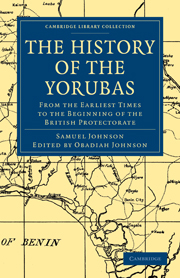1 - INTRODUCTION
Published online by Cambridge University Press: 05 July 2011
Summary
The Yoruba country lies to the immediate West of the River Niger (below the confluence) and South of the Quorra (i.e., the Western branch of the same River above the confluence), having Dahomey on the West, and the Bight of Benin to the South. It is roughly speaking between latitude 6° and 9° North, and longitude 2° 30' and 6' 30' East.
The country was probably first known to Europe from the North, through the explorers of Northern and Central Africa, for in old records the Hausa and Fulani names are used for the country and its capital; thus we see in Webster's Gazetteer “Yarriba,” West Africa, East of Dahomey, area 70,000 sq. miles, population two millions, capital Katunga. These are the Hausa terms for Yoruba and for Oyo.
The entire south of the country is a network of lagoons connecting the deltas of the great River Niger with that of the Volta, and into this lagoon which is belted with a more or less dense mangrove swamp, most of the rivers which flow through the country North to South pour their waters.
It will thus be seen that the country is for the most part a tableland: it has been compared to half of a pie dish turned upside down.
- Type
- Chapter
- Information
- The History of the YorubasFrom the Earliest Times to the Beginning of the British Protectorate, pp. xix - xxiiPublisher: Cambridge University PressPrint publication year: 2010First published in: 1921



